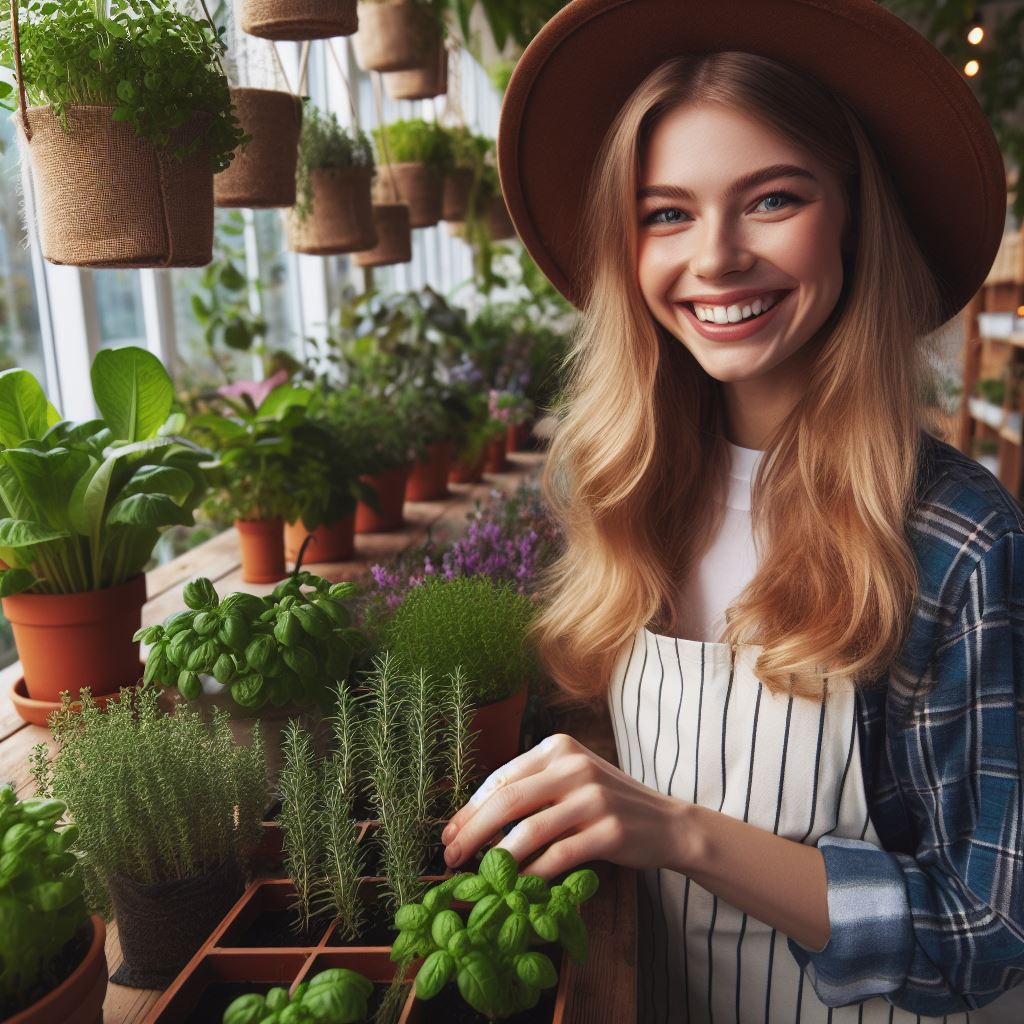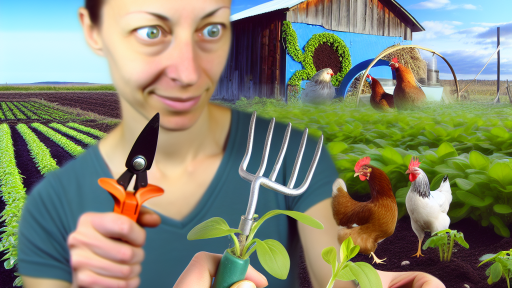Introduction
Craving fresh herbs to elevate your culinary creations?
Don’t let limited space hold you back! Indoor herb gardens offer a simple yet rewarding solution, transforming even the most compact living areas into vibrant sources of flavor.
Imagine snipping fresh basil for homemade pesto, adding the invigorating touch of mint to summer cocktails, or garnishing dishes with fragrant rosemary sprigs – all grown right in your own home.
Indoor herb gardens go beyond enhancing your culinary skills.
They bring life and a touch of nature indoors, boosting air quality and fostering a sense of serenity.
Plus, the convenience of having fresh, potent herbs readily available encourages healthy eating habits and minimizes food waste.
This comprehensive guide empowers you to cultivate a thriving herb haven, regardless of space limitations.
We’ll delve into selecting the perfect herbs, choosing suitable containers, and creating an ideal growing environment for your culinary companions.
So, get ready to unlock the potential of “big yields” in your “small space” herb garden!
Choosing the right herbs for indoor gardening
Popular herbs that thrive indoors
- Basil: Adds a fresh and aromatic flavor to many dishes and requires plenty of sunlight.
- Rosemary: A woody herb that adds a distinctive flavor to savory dishes and only needs moderate light.
- Thyme: Perfect for adding depth to both meat and vegetable dishes, it prefers bright but indirect light.
- Mint: Refreshing and versatile, this herb thrives in low light conditions and adds a burst of flavor to drinks and desserts.
- Parsley: A staple herb in many cuisines, parsley requires moderate light and regular watering.
Factors to consider when selecting herbs
- Light requirements: Different herbs have varying light needs, so assess the lighting conditions in your indoor space.
- Space constraints: Consider the available space you have for your indoor garden and choose herbs that fit well.
- Watering needs: Some herbs are more drought-tolerant, while others require consistent moisture, so choose accordingly.
Recommended herbs for beginners
- Chives: These herbs are forgiving and can handle varying light conditions, making them ideal for beginners.
- Oregano: This resilient herb is low-maintenance and can thrive with moderate light and infrequent watering.
- Sage: With its ability to withstand dry conditions and low light, sage is a great herb for beginners.
- Dill: Easy to grow indoors, dill can tolerate lower light levels and does not require excessive watering.
- Cilantro: A fast-growing herb that can adapt to different light conditions, making it suitable for beginners.
Factors to consider when selecting herbs
When choosing herbs for indoor gardening, it’s essential to consider their light requirements, space constraints, and watering needs.
Some herbs, such as basil or rosemary, need plenty of sunlight to thrive, while others like thyme or mint can tolerate lower light levels.
Assess the lighting conditions in your indoor space to ensure you select herbs that will receive adequate light.
Another crucial factor to consider is the available space.
If you have limited room, choose herbs that don’t require much space to grow.
Herbs like chives or dill are excellent choices for compact environments.
Transform Your Agribusiness
Unlock your farm's potential with expert advice tailored to your needs. Get actionable steps that drive real results.
Get StartedOn the other hand, if you have more space available, you can experiment with a variety of herbs.
Watering needs vary among herbs as well.
Some herbs, like cilantro or parsley, require consistent moisture, while others, such as sage or oregano, are more drought tolerant.
Consider your routine and availability to water your herbs regularly, especially if you have a busy schedule.
Recommended herbs for beginners
For beginners, it’s best to start with herbs that are easy to grow and maintain.
Chives are forgiving and can adapt to varying light conditions, making them a great choice for beginners.
Oregano and sage are also low-maintenance herbs that can thrive with moderate light and infrequent watering.
Additionally, dill and cilantro are fast-growing herbs that can adapt to different light conditions, making them suitable for beginners as well.
In general, selecting the right herbs for indoor gardening is crucial for their successful growth.
Consider their light requirements, space constraints, and watering needs when making your choices.
Beginners can start with forgiving herbs like chives, oregano, sage, dill, or cilantro.
With the right selection, you’ll enjoy a fresh and flavorful indoor herb garden in no time.
Read: Micro Farming: Grow More in Less Space
Setting up an indoor herb garden
Setting up an indoor herb garden requires careful consideration of several factors to ensure successful growth and bountiful yields.
From selecting appropriate containers to choosing the right soil and location, each step plays a crucial role in creating a thriving indoor garden.
Selecting appropriate containers
When choosing containers for your indoor herb garden, aesthetics and practicality should be taken into account.
Opt for containers that match your home decor and are easy to maintain.
Additionally, ensure that the chosen containers have proper drainage holes at the bottom.
This is essential to prevent overwatering and waterlogging, which can be detrimental to the herb plants’ health.
Determining the ideal location for your indoor garden
The location of your indoor herb garden is crucial for the plants’ overall well-being.
Evaluate the available light sources in your home and place the garden near a sunny window or under grow lights.
Adequate light is essential for photosynthesis and healthy growth.
Additionally, consider temperature and humidity levels.
Keep the herbs away from drafts and extreme temperature variations, as these can stress the plants.
Showcase Your Farming Business
Publish your professional farming services profile on our blog for a one-time fee of $200 and reach a dedicated audience of farmers and agribusiness owners.
Publish Your ProfileMaintaining moderate humidity levels will also promote optimal growth.
Choosing the right soil and fertilizers
Selecting the appropriate soil and fertilizers is vital for the success of your indoor herb garden.
Opt for well-draining soil that provides adequate aeration and moisture control.
Specifically designed potting mixes for indoor gardening are available in garden centers.
These mixes usually contain a combination of peat moss, perlite, and vermiculite.
These ingredients promote good drainage and root development.
When it comes to fertilizers, organic options are highly recommended.
Compost and liquid seaweed extract are excellent choices for small space gardening.
These organic fertilizers provide essential nutrients without the risk of chemical buildup or harm to the environment.
By following these guidelines, you can set up an indoor herb garden that will provide you with fresh and flavorful herbs all year round.
Remember to water your plants regularly, but avoid overwatering, as this can lead to root rot.
Monitor their growth and address any signs of pests or diseases promptly.
With proper care and attention, you can enjoy the satisfaction of growing your own herbs indoors, even in small spaces.
Read: Easy Herbs for Window Gardening Success
Caring for Indoor Herb Plants
Indoor herb gardening can be a rewarding and convenient way to enjoy fresh herbs year-round.
However, providing proper care is essential to ensure their health and productivity.
In this section, we will explore the necessary steps to effectively care for your indoor herb plants.
Understanding the Watering Needs of Herbs
When it comes to watering your indoor herb plants, it’s crucial to strike the right balance.
Overwatering can lead to root rot and other issues, while under-watering can cause stunted growth and wilted leaves.
To avoid these problems, follow these tips:
- Avoiding overwatering and root rot: Allow the soil to dry out between waterings to prevent waterlogged roots. Herbs like well-draining soil, so ensure your pots have drainage holes.
- Monitoring soil moisture levels: Use a moisture meter or the simple finger test. Stick your finger into the soil up to an inch deep. If it feels dry, it’s time to water. If it’s still moist, wait a bit longer.
Providing Adequate Lighting
Light is vital for photosynthesis and the growth and development of your indoor herb plants.
While some herbs can tolerate lower light conditions, most thrive with bright, direct or indirect sunlight.
Follow these suggestions for optimal lighting:
- Natural light sources and supplemental lighting options: Place herb plants near south or west-facing windows to maximize natural light exposure. For areas with limited sunlight, consider using LED grow lights to supplement light requirements.
- Recommended light duration for various herbs: Most indoor herbs require around 12-16 hours of light per day. However, some herbs, like parsley and cilantro, can tolerate slightly less, while basil and thyme benefit from more extended light exposure.
Managing Temperature and Humidity Levels
Creating a favorable environment for your herb plants involves maintaining suitable temperature and humidity levels.
Excessive heat, cold drafts, or drastic temperature fluctuations can harm their growth. Follow these guidelines to ensure proper temperature and humidity:
- Creating a suitable microclimate indoors: Position your herbs away from drafts, open windows, or doors. Keep them in a warm, stable environment, avoiding extreme temperatures.
- Avoiding extreme temperature fluctuations: Herbs prefer temperatures around 60-75°F (15-24°C). Avoid placing them near heating or cooling vents, as sudden temperature changes can stress and damage the plants.
By understanding and implementing the proper care techniques for your indoor herb plants, you can enjoy bountiful yields of fresh, flavorful herbs throughout the year.
Remember to water wisely, provide adequate lighting, and maintain a stable microclimate for optimal growth.
With these tips, your indoor herb garden will thrive, bringing both beauty and practicality to your small space.
Read: Grow Herbs on Your Porch: Simple Techniques

Harvesting and using herbs from your indoor garden
Knowing when to harvest herbs
- Watch for signs of maturity, such as the plant reaching a suitable height or flowering.
- Harvest herbs in the morning after the dew has dried but before the heat of the day.
- Observe the growth habits of different herbs as some can be harvested throughout the growing season.
Proper techniques for harvesting to promote growth
- Use clean and sharp scissors or pruning shears to avoid damaging the plant.
- Cut above a node or leaf joint to encourage new growth and prevent bare stems.
- Avoid cutting more than one-third of the plant’s foliage at a time to maintain its health.
Drying and storing herbs for future use
- Select a drying method based on the herb’s moisture content and desired results.
- Air drying: Tie small bunches of herbs together and hang them upside down in a well-ventilated area.
- Dehydrator: Spread the herbs evenly on the trays and set the dehydrator to a low temperature (around 95°F).
- Store dried herbs in airtight containers, away from direct light and heat, to maintain flavor and potency.
Exploring culinary and medicinal uses for homegrown herbs
- Culinary uses: Enhance your cooking with fresh herbs by incorporating them into various recipes.
- Infuse herbs into oils, vinegars, or spirits to create flavored bases for dressings, marinades, or cocktails.
- Medicinal uses: Research the medicinal properties of different herbs and their potential health benefits.
- Create herbal teas, tinctures, or salves using your homegrown herbs for natural remedies and wellness.
In essence, harvesting and using herbs from your indoor garden can be a rewarding and enjoyable experience.
By knowing when to harvest, using proper techniques to promote growth, and drying and storing herbs correctly, you can ensure the best quality and flavor for future use.
Additionally, exploring the culinary and medicinal uses of your homegrown herbs allows you to enhance your cooking and promote natural wellness.
So, continue to nurture your indoor garden and savor the abundance of flavors and benefits it brings.
Read: Urban Veggie Gardens: Small Spaces, Big Yields
Common challenges and troubleshooting tips
Recognizing and addressing common pests and diseases
- Regularly inspect your indoor herbs for signs of pests such as aphids, mites, or whiteflies.
- If you notice any pests, isolate the affected plant immediately to prevent the infestation from spreading.
- Use organic pest control methods like neem oil or insecticidal soap to treat minor pest problems.
- For more severe infestations, consider using natural predators such as ladybugs or predatory mites.
- Fungal diseases like powdery mildew or root rot can be prevented by providing proper air circulation and avoiding overwatering.
- If your herbs show signs of disease, remove the infected parts and apply a fungicide recommended for edible plants.
- Regularly clean and disinfect your gardening tools and containers to prevent the spread of diseases.
Dealing with inadequate growth and nutrient deficiencies
- Ensure your indoor herbs are receiving sufficient light. Place them near a south-facing window or use grow lights.
- Check the soil moisture regularly and water your herbs when the top inch of soil feels dry to the touch.
- Use a well-draining potting mix and ensure proper drainage to prevent waterlogged roots.
- Consider using a slow-release organic fertilizer or liquid fertilizer specifically formulated for herbs.
- Yellowing leaves or stunted growth may indicate nutrient deficiencies. Adjust the fertilizer accordingly.
- Avoid over-fertilization as it can lead to nutrient burn and harm your herbs. Follow the instructions on the product.
- If your herbs still show inadequate growth, consider repotting them into a larger container with fresh soil.
Maintaining healthy and productive herbs in the long run
- Regularly prune your herbs to promote bushier growth and prevent them from becoming leggy.
- Harvest herbs frequently to encourage new growth and prevent them from flowering, which can affect flavor.
- Provide proper air circulation by spacing out your herbs and avoiding overcrowding.
- Keep a vigilant eye on the overall health of your herbs and address any issues promptly.
- Rotate your herbs’ positions periodically to ensure uniform light exposure and prevent one side from becoming leggy.
- Keep an eye out for signs of stress, such as wilting or yellowing leaves, and adjust light, temperature, or watering accordingly.
- Lastly, enjoy the process of growing your indoor herbs. Experiment with different varieties and flavors to enhance your culinary experience.
Remember, growing herbs indoors can be a rewarding experience despite the challenges that may arise.
With careful attention and proper troubleshooting, you can maintain a thriving herb garden in even the smallest of spaces.
Keep learning and adapting your techniques to ensure long-term success. Happy growing!
Conclusion
Recap of the benefits of growing herbs indoors
Growing herbs indoors offers numerous benefits, including easy accessibility, fresh flavors for cooking, and adding beauty to your home.
Encouraging readers to start their own indoor herb garden
Now that you know the advantages of growing herbs indoors, it’s time to start your own indoor herb garden.
With just a little effort and the right equipment, you can enjoy fresh herbs all year round.
Showcase Your Farming Business
Publish your professional farming services profile on our blog for a one-time fee of $200 and reach a dedicated audience of farmers and agribusiness owners.
Publish Your ProfileFinal thoughts and inspiring tips to maximize yields in small spaces
Although space may be limited, there are a few tips to maximize yields in your small indoor herb garden.
First, choose compact varieties of herbs that are suitable for indoor gardening.
Ensure your herbs receive sufficient sunlight by placing them near a south-facing window or using grow lights.
Water your herbs regularly, but be careful not to overwater them, as this can lead to root rot.
Fertilize your herbs with organic nutrients to promote healthy growth and maximize flavor.
Trim and harvest your herbs frequently to encourage new growth and prevent them from becoming leggy.
Finally, enjoy the fruits (or rather, herbs) of your labor by using them in your favorite dishes.
In a nutshell, growing herbs indoors is a rewarding and practical hobby that can be done even with limited space.
Start your own indoor herb garden today and enjoy the benefits of fresh herbs throughout the year!




